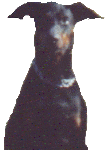Substituting
signals are used in the following cases:
- impossibility of
reflecting any ride-allowance signal,
- so-called
'doubtful signal' appeared on the semaphore
(this means reflected signal doesn't match to
any pattern),
- no light is on,
Besides, such signal must
be given, when:
- the train enters
the station or manually controlled block,
using the wrong track (because the railtrafic
in Poland is right-based, so the situation
described means the train uses left-side
track)
- the train is to
leave the station and no exit-semaphore is
concerned with the track on which the train
stopped
After passing the
substituting signal, the speed is limited to 40 km/h,
with regard to the possibility of sudden stop. If the
train enters the track provided with automatic block
control, and this entering was caused by reflecting
the substituting signal, the speed is limited to 20
km/h until passing the semaphore reflecting ride
allowance signal (unless the loco-engineer was given
an order telling the cancellation of the automatic
block control semaphores).
Substituting signals
are named 'Sz' ('sygnal zastepczy' in Polish) and
numbered according to the internal station scheme.
Substituting signal
may be reflected on a standard semaphore (if
provided) or it can be posted as a separate
semaphore, or even as a dwarf semaphore. If separate,
'Sz' signal is not provided with forewarning signal.



